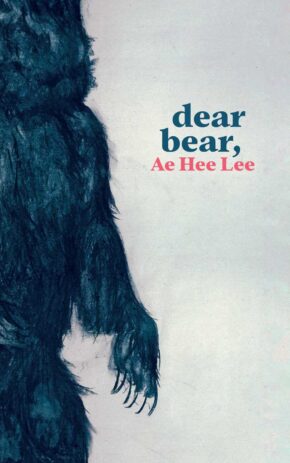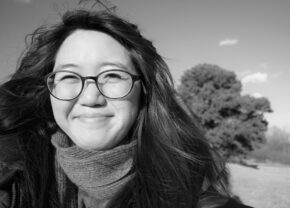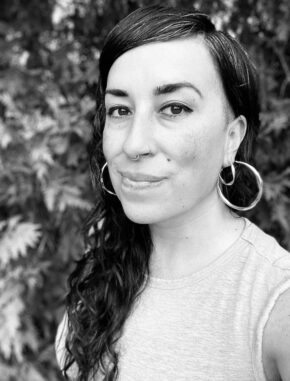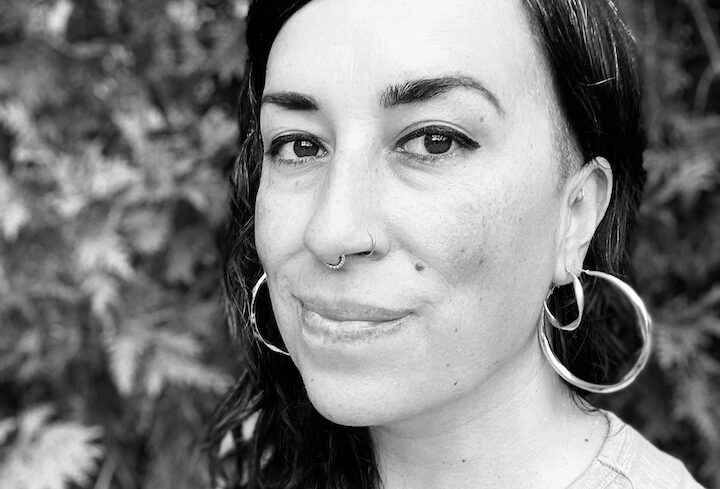“Maybe the World Had to End So We Could Finally Love”: An Apocalyptic Dream in Letters (Interview with Ae Hee Lee)
heidi andrea restrepo rhodes
 Born in South Korea, raised in Peru, Ae Hee Lee currently lives in the United States. She is the author of the poetry chapbooks: Bedtime || Riverbed (Compound Press, 2017), Dear bear, (Platypus Press, 2021), and Connotary, which won the 2021 Frost Place Chapbook Competition with Bull City Press. Most recently, her first full-length poetry collection ASTERISM was awarded the 2022 Dorset Prize. Her poetry has been published or is forthcoming at Poetry Magazine, Poetry Northwest, The Georgia Review, New England Review, and Southern Review, among others.
Born in South Korea, raised in Peru, Ae Hee Lee currently lives in the United States. She is the author of the poetry chapbooks: Bedtime || Riverbed (Compound Press, 2017), Dear bear, (Platypus Press, 2021), and Connotary, which won the 2021 Frost Place Chapbook Competition with Bull City Press. Most recently, her first full-length poetry collection ASTERISM was awarded the 2022 Dorset Prize. Her poetry has been published or is forthcoming at Poetry Magazine, Poetry Northwest, The Georgia Review, New England Review, and Southern Review, among others.
In the following interview by poet heidi andrea restrepo rhodes, focusing on Dear bear, Lee reflects on ego and desire, circularity and inseparability, and possibilities for intimacy and aliveness outside of and against societal convention and capitalist relation. The protagonist of Dear bear, the speaker of Lee’s poems, contends with “the physical and metaphysical borders that surround the self” while also being “entangled with bear, the camelia, and the forest.” Excerpts from the collection can be read at Four Way Review and the Michigan Quarterly Review.
heidi andrea: From what urgencies or questions in your life did this series of poems emerge? What research? What pressing spirit?
Ae Hee: I wrote my first Dear bear, poem for my first boyfriend. I had this bubbling urge to communicate and record all these new feelings I was experiencing. Initially, the poems were about our relationship, then I became interested in the idea of relationship in and of itself. I started to think about loneliness and wholeness, power dynamics and sincerity, my relationship with people and God. As I kept reading news articles about oil spills and extreme fluctuations of weather, I reflected more seriously about our capitalist relationship with nature as well. I noticed it was often about “making the most” of certain resources or relegating environmental concerns until an obvious crisis happened. When I put my collection together, I set it in a postapocalyptic world, wondering what different relationships could look like once they were “free” or torn away from past societal conventions and structures, physical and metaphysical borders that surround the self.
I have a sad little thought that we are creatures of regret. Time and again we seem to love too late in a way in which the other feels loved. On a personal level, Dear bear, was a reminder to myself to love deeply while I can. That said, a couple of months ago I was thanking Valerie Mejer for providing my chapbook with a blurb when she referred to Dear bear, as an “ecology of relationships.” It blew my mind because she had so beautifully summed up all my convoluted thoughts in just a few words.
heidi andrea: Yes! I recently took a Lyric Ecology workshop with Sami Ghaus, and even as our collective definition of “lyric ecology” continues to morph, I was struck by how much Dear bear, feels kin to what that might mean. Can you talk about your relationship to lyric writing and to the ecological?
Ae Hee: I’m enamored with the word ecology. I love lyric too, but ecology— I love how it notes the relation between beings and surroundings rather than looking at a single organism as the center of all things. As I was writing Dear bear, I kept experimenting with its form and tone to see if I could write poems in the lyrical first person and at the same time have the collection be about the speaker set within the world, entangled with bear, the camelia, and the forest. This ultimately led me to leave the speaker nameless, but I’m not sure if I succeeded in decentering her completely. Still, writing the book has made me conscious of the fact that while I too look at the world with myself as the “protagonist” of my story, I exist in connection to everything and what I do has consequences that extend beyond myself.
heidi andrea: Do you write in nature itself? How does nature speak to you? Does nature bring you poems? What does poesis in the company of nature, collaborating with nature, look like for you?
Ae Hee: Yes, yes, and yes! I do not write in nature all the time, so it might be more accurate to say I enjoy writing on the move a lot, but one of my favorite parts is feeling the wind of the season on my cheeks and breathing in. It is usually the smallest details of nature that move me and make me write poems, like the fractals inside a chamomile bud. For me they are reflections of a vast and infinite imagination, and it is always a wonder to realize the way they are connected to the all. In other words, collaboration for me looks a lot like learning.
heidi andrea: The epistolary poem comes out of various longtime traditions: in the West, the oft-cited origins being in Ancient Greece and Rome. What drew you to this form?
Ae Hee: I’m not very good at real-time chatting or social media, though I’ve been trying to be more proactive at both: I have preferred the epistolary form since I was a child. I would ask to swap journals with my friends and found it exciting to send and receive handwritten postcards and long letters.
There is something alluring in the privacy of the epistolary form, in a conversation that only exists in one (fleeting) place in the universe. And yet when these conversations accumulate, they can be (re)read to (re)build worlds, lives, and relationships. I think it’s wonderful.
heidi andrea: There is a tenderness to these poem-epistles. How did you arrive at bear as your correspondent? It strikes me at times that across the poems, bear appears more literal; at other times, metaphorical and symbolic, even metonymic. Who and what and where and when and why is bear? And who do you imagine is the speaker of the poems—who is the voice penning the letter?
Ae Hee: bear was inspired by my boyfriend, but bear exceeded him soon after and became its own bear. I don’t want to say too much about it, because I feel I would be limiting the possibilities that I wanted bear to be. bear is who and what and where and when and why, I think. You can touch it and give meaning to it, and it will touch you and give meaning to you too. At least it did so to me. As for the speaker, I initially wrote her as an alter ego of mine, like an unrestricted version of myself. What resulted was a bundle of contradictions (terrified of desire and filled with it, selfless and full of self), not very unlike anyone else.
heidi andrea: Can you talk about your writing process, and from what you source inspiration?
Ae Hee: I think it’s curiosity that leads me to write. If there is a subject or idea I find interesting or maddening, I’m compelled to write a poem about it. As I write, I stumble upon interesting connections and new questions. I like being surprised by the poem. Sometimes, I get stuck. The poem doesn’t budge, and I let it be. I leave it unfinished, until one day, as I’m walking down the street or enjoying a tree’s shade or am reading a book, the poem starts to move again. I take out the small notebook I carry everywhere and write the words down. Sometimes, I realize I had misunderstood, and the words were not for the poem I had initially considered. I keep gleaning the pieces until another poem is born out of them.
Like Antonio Machado writes, “Caminante, no hay camino, se hace camino al andar.”/ “Wayfarer, there is no road, the road is made as you continue to walk.” (My mentor, Mauricio Kilwein Guevara, once quoted this line at the start of a workshop and it has accompanied me since).
 heidi andrea: You were born in Korea, raised in Peru, and now live in the United States. In what ways do you see your experiences of place, belonging and estrangement, home and migration, culture and language, informing your poetry? Who are the ancestors by blood or shared history, what are the worlds, for whom and for which you write?
heidi andrea: You were born in Korea, raised in Peru, and now live in the United States. In what ways do you see your experiences of place, belonging and estrangement, home and migration, culture and language, informing your poetry? Who are the ancestors by blood or shared history, what are the worlds, for whom and for which you write?
Ae Hee: Language has always been a strange thing for me. Korean makes Spanish and English strange, and Spanish makes English and Korean strange, and English makes Korean and Spanish strange. They keep changing each other and my way of thinking through all of them, be it in the level of grammar, image, or sound. My verses are constantly born from this strangeness.
As for the second question, I tend to write for the people I love (and will love) and the kind of world I want to live in. It might be because of the feelings of alienation I’ve experienced growing up, but when I write poetry, I have this desire to make a new place of belonging through it. I insist on tenderness, vulnerability, and intimacy, because I want to resist the discourse surrounding belonging that hinges on exclusion and is perpetuated by those in power.
heidi andrea: What other writers or works or histories do you think most closely informed how this collection unfolded for you?
Ae Hee: When I lived in Peru, a friend of mine would recite Pablo Neruda’s love poems by heart. Even when I wasn’t personally familiar with romance at that age, the earnestness in my friend’s voice made a deep impression on me.
I also grew up with my mother reading me Korean myths and folktales and Biblical stories under the lamplight. And at school, I learned about Incan legends and read Western fairytales. There is a lot of creation going on in these, and much destruction too. As a child who constantly liked to ask why and how questions, I was fascinated by the ways these narratives tried to make sense of the world. They are probably what inspired me to write the kind of creation love story of a world that “ended” and engage in conversation with common character and relationship archetypes. I’m sure my rather senseless love for bears comes from these too.
There were a lot of stories with bears in them, after all. The ones that come to mind immediately are “Goldilocks and the Three Bears,” and the Korean founding myth of the Ungnyeo, in which a bear eats a bundle of mugwort and garlic for several days in a cave to become a woman. Finally, I cannot leave out Marosa di Giorgio. When I encountered her work for the first time, I was mesmerized by the ornate and yet wild manner she wrote about nature and created a prose-poetic world that proliferates between the imaginary and real. The surreal character of Dear bear, was greatly influenced by her writings.
heidi andrea: The collection begins with an end, reaches for the end of the world as beginning. You write, “maybe the world had to end so we could finally love,” and I read moments like these in the poems as aligned with a lot of the feminist theory and literature that envisions the end of the world as the end of capitalism and the end of the self-devouring hunger of colonizing enterprise. Are you influenced by these works? (Or if not, what has shaped your own questions about the end of the world?) What does the end of the world mean to you?
Ae Hee: Oh most definitely! I return most often to Borderlands/La Frontera: The New Mestiza by Gloria E. Anzaldúa. The way she frames a necessity for a (re)construction and (re)understanding of identity and the world through the deconstruction of both is inspiring to me on so many levels. “Maybe the world had to end so we could finally love” speaks to this kind of process too. I see love as a creative force. Initially, I imagined that it would only be able to truly burgeon when systems that constantly limited and exploited it collapsed. I later added “but since the cosmos remains inside of us, it must be all the more complicated than that,” because it occurred to me everything, including love and memory, exists constantly across time just in different forms. I also wanted to acknowledge how deeply the systems you mention are ingrained in our lives. It requires more than a physical end of the world for them to be put behind. Something better needs to take its place and even this must be infinitely re-evaluated. It’s a circular journey; I’ve heard a circle doesn’t have a beginning or end, but then it’s also true that every part of the circle is simultaneously a beginning and an ending.
heidi andrea: Across Dear bear, the huntsman stands in for capitalism, patriarchy, colonization (“the uninvited”). He symbolizes the violence of commodification of nature and nature-made-trophy, of “blunt force trauma.” In contrast, the forest lives as a place of respite and escape, a nationless borderlands that evades the property relation altogether. These contrasting images are among the most present in the story these poems tell. What led you to them?
Ae Hee: I come from a Christian household and have retained my faith, but much of it consists in continuing to ask questions and grappling with my beliefs and certain concepts I grew up with. One of them is the idea of paradise, which eventually led me to the forest. I was uncomfortable with how both were commonly depicted or interpreted as unidimensional places defined by human convenience, passive settings on which characters act, or completely unapproachable objects of people’s awe. I wanted to try portraying the forest as an entity that had narratives of its own and was constantly expanding, that lay beyond the speaker’s understanding, but that was open to being known and unknown.
The character of the huntsman came after the forest (uninvited!). It was like I took my eyes off the poems and looked back and there he was. It was an eerie moment. But I think he came as an accumulation of certain characters I have observed throughout my life. Characters that tended to represent a sort of mastery/domination over nature, accountable to no one, and yet were often depicted as heroic figures. In relation to the forest, it was not very difficult to highlight the darker implications of such characteristics that are still largely seen as socially acceptable.
heidi andrea: I’m struck by the way you write intimacy. At times, with bear, the speaker of the poem seems to contend with the inseparability of desire and consumption, their convergence leading to subjugation, assimilation, alienation–which speaks to a certain inevitability of our participation in the destruction of the world, despite all intentions otherwise. In other moments, there is this quieter, deep-feeling relationality with bear and with the forest that is based in care, and understands the natural world as full of symbiotic forms, beings, a planetary riot of life asking for protection, and with whom together we might find material and spiritual flourishing. You envision “the strange company of flora”; the eroticism, which is to say, the aliveness, of witnessing the work of blossoms and bees. The “other” is always a site of possible violence and horror as well as possible beauty and what Patrick Rosal has called “mutual regard.”
Ae Hee: Thank you for this attentive reading. I especially appreciate how you bring “intimacy” and “inseparability” into this conversation. I tend to see desire, consumption, subjugation, assimilation, alienation, loss, loneliness, love, and the whole gamut of emotions and actions as existing in relation to one another and made of many smaller fragments, rather than incongruent or neatly independent/whole concepts. They are “inseparable” in that sense. On the other hand, “intimacy” indicates a sort of agency for me. I think intimacy happens when parties choose to open themselves to an ongoing conversation and listen to each other. It is directly tied to care, to consider something outside oneself (the “other”) to be of equal importance. To care for the world would therefore mean to be as alive as you can be with others, not by stepping over them.
 heidi andrea restrepo rhodes is a queer, disabled, brown/Colombian poet, scholar, and cultural worker. Her collection, The Inheritance of Haunting (University of Notre Dame Press, 2019), won the 2018 Letras Latinas Andrés Montoya Poetry Prize. Her work has been published in Poetry, the Academy of American Poets’ Poem-a-Day, Nat. Brut, Foglifter, and Waxwing, among other places.
heidi andrea restrepo rhodes is a queer, disabled, brown/Colombian poet, scholar, and cultural worker. Her collection, The Inheritance of Haunting (University of Notre Dame Press, 2019), won the 2018 Letras Latinas Andrés Montoya Poetry Prize. Her work has been published in Poetry, the Academy of American Poets’ Poem-a-Day, Nat. Brut, Foglifter, and Waxwing, among other places.

